- Home
- Barbara W. Tuchman
Stilwell and the American Experience in China, 1911-45 Page 7
Stilwell and the American Experience in China, 1911-45 Read online
Page 7
His chance came in the summer of 1914 when, having been transferred to the Department of Modern Languages to teach Spanish, he contrived an assignment to Madrid for further language study. On June 29, while in Spain, he closed an account of a day’s excursion to the countryside with a parenthetical note, “(Assassination in Bosnia).” For the next few weeks, like most of the world, he gave no further thought to the incident at Sarajevo until July 30 when he read the news of Austria’s bombardment of Serbia. “Very serious war news. Seems a dream that Europe is about to jump into the abismo.”
Returning to the old routine of teaching at the Academy was not exhilarating and nothing happened to change the routine during the next two years. Stilwell’s efforts to get overseas as an observer with the French Army were in vain. In reply to his application the War Department stated in December 1915 that it had already sent five officers abroad to observe the European war (which now engaged the armies of ten nations from the Channel coast to Mesopotamia) and “it is not planned to send any more.”
But the movement for preparedness was gaining and in April 1916 brought about passage of the Army Act authorizing a doubling of Regular Army strength to a maximum of 288,000 over a period of five years. Stilwell’s first war service was as an instructor in the summer of 1916 at Plattsburg, New York, where the first training camp to prepare Reserve officers from civilian life was established. In September after twelve years as a lieutenant he was at last promoted to captain.
In April 1917 the United States, with an Army of 133,000 men, entered the war in which the belligerents had more than six million men engaged on the Western Front alone. The European national forces were organized into armies each containing three to five corps, each corps usually consisting of two divisions. The American Army had no organized military unit higher than a regiment. Although the divisional structure existed on paper, no American soldiers since the Civil War had taken the field as a division, with all the coordination of infantry and artillery, of staff and field, of intelligence and operations, that that requires. All this had to be learned and put into practice. A national army fleshed out to ten times the size of its existing regimental skeleton had to be created, which meant recruited, officered, trained, equipped, shipped overseas, assembled, supplied, coordinated in its arms and branches, and further trained before it could fight. For this task the General Staff had made no arrangements or any general plan of mobilization.
The issue having been forced, a Selective Service Draft law was enacted in May 1917 authorizing conscription of a million men. After investigation in Europe it was realized that plans for the future should be based on three times that number. The specter of the number of officers required for this newly hatched giant of an army—about one for every twenty men or 50,000 for an army of a million—appalled the Regulars. In the first year of war, training camps in a series of three-month courses turned out 57,000 officers, ten times as many as West Point had graduated in all its history.
Training was the tremendous task that dwarfed everything else. To create through training an army that could take the field effectively was to be the central purpose a quarter-century later of Stilwell’s work in China, as it was now that of the United States. The first essential in war is an army that will not run away, which can only be assured by training. Without training, a soldier is not worth what it takes to put him in position, an officer is useless, an army is a rabble. General Hunter Liggett, head of the War College, soon to command the 1st Division and ultimately the American First Army, unsparingly estimated that one well-trained, well-equipped foreigner could whip ten good but untrained Americans. An untrained American Army of 5,400, he pointed out, ran away from 1,500 British Regulars in the War of 1812 and did not stop until they were 15 miles on the other side of Washington. In the three days it took to reassemble them the British burned the capital. To create an American force capable of playing an independent American role in the war rather than serving as a depot of fillers for Allied ranks (which was what the Allies wanted) required training as American units under American officers. Professional officers at once became precious assets and they were soon so widely scattered in training duties detached from their own units that half of them were never to go overseas at all.
Though first requested as an instructor for the training camps, Stilwell escaped that fate when other orders detailing him as brigade adjutant to the 80th Division at Camp Lee in Virginia took precedence. Promoted to the temporary rank of major, he arrived at Camp Lee on August 25, 1917, missing by a hair another proposal that might have changed his career. His persistence over the years in visiting Spanishspeaking countries now bore fruit in the offer of an appointment as Military Attaché in Spain. This was “no swivel chair job,” wrote his correspondent in the War Department; on the contrary, “Spain is full of spies and German agents,” and a good man was needed “for the purpose of running an Espionage system.” Stilwell was asked to reply by telegram “right away,” but on the day the letter was despatched he had already reached Camp Lee.
Four months later in December 1917 he received orders to go to France to report to the Commanding General AEF for Intelligence duty. He was to be a staff officer. That a man of his physical energy and aggressiveness should find himself assigned to staff instead of line was the ironic yet reasonable result of the course his career had already taken. Though not a graduate of the command and staff courses at Leavenworth and the War College, whose graduates were now filling all the higher posts in the AEF, his command of French was badly needed.
From the day America entered the war the Allies brought unremitting pressure upon everyone from President Wilson down to feed American soldiers in battalion or smaller units into the thinned and battle-worn Allied divisions. Their lack of training would be made up, it was insisted, by serving with seasoned troops, no time being lost in the process.
General John J. Pershing, the iron-willed cavalryman who commanded the American Expeditionary Force, was adamant in refusal. Politically he was carrying out the mandate of his Government, for it was clear that to allow integration of American soldiers into Allied ranks would be to commit America’s fortunes to the Allies’ and preclude the United States from determining her own policy and from playing a major role at the peace table. Militarily he had his own reasons. He believed the deadlock of trench warfare could only be broken and victory won by restoring a war of movement, that is, by abandoning the offensive of limited objectives followed by consolidation of position, which had become the pattern of the Western Front, in favor of open warfare whose aim was to penetrate rather than consolidate. He intended to accomplish this by an American injection of the offensive spirit and an American philosophy of warfare prescribing maximum initiative in the field by troops and subordinate officers who would be trained to exploit every opportunity. Pershing wanted brief orders, concentrating on the objective, rather than the Allied practice of detailed, phase-by-phase plans and rigidly controlled movements. Since British and French training had become adapted to the methods and weapons of trench warfare, he could only prove his program by American training and only implement it by an independent American Army operating in an American sector. The spirit and method of this program was what Stilwell, a Pershing without an AEF, tried to transplant to Chinese troops one war later.
Arriving in France with his Headquarters staff in July 1917, Pershing looked for a sector where a decisive military result could still be gained. He fixed on the triangle below Verdun and Metz where the German-held St. Mihiel salient had protruded since 1914. The salient controlled both the rich Briey iron basin and one of two vital railroads supplying the German armies in France. Here, Pershing considered, was the enemy’s solar plexus. Metz was the crux of the German defense system and a penetration on either side of it would open the way to Germany. An offensive here, Pershing believed, could only be carried through by the impetus of a fresh army. Heavily fortified by the Germans who realized its vulnerability, the St. Mihiel salient had defied th
e Allies who had never mustered the force to attack it.
Meanwhile he had to create an army. After the hurrahs for the 1st Division, hurriedly put together and rushed to France in July, no more followed for three months. Shortage of ships and muddle in the War Department as well as lack of trained men caused the delay. Three more American divisions arrived in October but all these, according to Pershing’s schedule, still needed three and a half more months to complete their training. By April 1918, a year after the declaration of war, only seven divisions had reached France.
Gloom pervaded the Allied camp at the time Stilwell arrived in France on January 21, 1918; pessimism was general, defeatism appearing. The withdrawal of Russia from the war, promising release of German divisions to the Western Front, was an immense disaster. The Allies’ offensives of 1917, bull-headed plunges into mass casualties with no strategic advantage gained, had so reduced reserves that commanders feared they would not be able to throw back a major German offensive if it came. With America’s troops withheld from them and unready for battle on their own, the Allies’ belief that they could sustain a war of attrition until American strength tipped the balance was shaken. To win by taking the offensive, a 20 percent superiority was considered necessary, which could not be attained without the addition of the Americans and they could not be ready before next summer. Since the logic of this was not lost on the Germans, they were not expected to be quiescent until summer came.
—
Another belligerent was prepared to take advantage of the hour. This was Japan, one of the Allied powers, who from the first had seen the embroilment of the white nations as her opportunity for expansion in China and the Pacific. In the words of Count Okuma, Premier in 1914, Japan was determined to become one of the world’s “governing nations.” China, appearing senile and beyond salvation, was marked for the role of first colony. The chief obstacle in the way was not China herself but the other powers. When they turned upon each other in 1914, Japan joined the Allies and as her contribution to the war effort seized Germany’s leased territory with its railroad and other concessions on the strategic Shantung peninsula. She also took from Germany the Marshall, Mariana and Caroline Islands in the Pacific, placing herself across America’s road to the Philippines.
Japan’s next move, the Twenty-one Demands, was designed to put her in administrative and economic control of China. Presented to Yuan Shih-kai in 1915, the demands required China to confirm Japan’s assumption of German rights in Shantung, extend her lease on former Russian rights at Port Arthur and Dairen to 99 years, concede various trade, land-owning, rail and industrial concessions in Manchuria, Inner Mongolia and the Yangtze valley, agree not to contract concessions or loans with any other power without Japan’s consent, and finally, in a fifth group which amounted to relinquishment of sovereignty, accept Japanese military, political and financial “advisers” and joint Japanese control of arsenals, police and schools.
Yuan Shih-kai, who was preparing to restore the monarchy with himself as Emperor, required support for his ambitions which were not popular. This was Japan’s opportunity and the Twenty-one Demands were her price. Yuan protested and resisted feebly but he could expect no aid from the Allies who were not prepared to thwart Japan for fear of causing her to change sides in the war to a more natural alliance with Germany. The United States, equally unwilling to interfere, created for the occasion the doctrine of nonrecognition to the effect that she would not recognize any arrangement imposed upon China in violation of the Open Door. This affected events no more than most statements of principle. Yuan maneuvered, managed to fend off the crucial fifth group of the Twenty-one Demands and succumbed to the rest. The anger and outrage felt by the Chinese when the agreement became known fostered a sense of nationhood. From that date on, China was to be on the whole anti-Japanese although groups who believed in accommodation continued to exist.
Three months after the Twenty-one Demands Yuan declared himself Emperor. While his instinct for a central authority may have been right, the form it took was unacceptable. The Revolution to that extent had been genuine. Public opinion exploded, provinces seceded. Yuan was force to cancel the decree in 1916 and died two months later of “disease and chagrin,” to be succeeded as President by Li Yuan-hung, the Colonel who had been pulled to prominence from under the bed.
He could control nothing and the rout began. China fell prey to the rival ambitions and private armies of the tuchuns, translated rather too grandly into English as “warlords.” Some were able governors and predators combined, others ignorant ex-bandits and adventurers tossed to the top in the general broil. Appointed military governor of a province by the nominal government in Peking, either in recognition of existing control or in consideration for support, the tuchun furnished and paid—or failed to pay—his own military forces. Chinese soldiers no longer served the state but feudal overlords who in constantly changing alliances traded and fought for power, gnawing like rats at what was left of the Republic. The “Government” of China recognized by the powers remained in Peking in the hands of a group of northern warlords known as the Anfu clique (from the provinces of Anhwei and Fukien) who owed their hold on office to Japanese support and loans. They adopted the terminology of republican government with a president, premier, ministers and a puppet parliament.
The Peking Government was declared illegal by the Kuomintang regime reestablished by Sun Yat-sen in Canton. He had returned in 1917, summoned the remnant of the original Kuomintang parliament to Canton and declared it to be the only constitutional government of China. Though his party had been born of Western ideas, and offered the only promise, if not the capability, of a new political order for China, it attracted no foreign support. From political inertia and natural preference, the foreign powers continued to deal with whatever tuchun group held the titles to office in Peking because this required no unsettling break in the succession. It is not in the nature of established governments to opt for change, even in their own interest. Sun Yat-sen maintained virtually a separate state dependent for military support on uneasy alliance with southern warlords. For the next decade, one of the most ruinous in China’s history, fragmentation proceeded, puppets and warlords held sway and the mandate of heaven held itself hidden.
As for Shantung, Japan knew that what counted to make her hold secure was confirmation by the powers. In March 1917, playing on, not to say encouraging, the fear that she might change sides in the war, she extracted secret agreements from Britain, France and Italy to support her claim to the German succession in Shantung and the Pacific islands at the peace table. When the United States entered the war Japan wanted to add American confirmation as well and succeeded in obtaining, in November 1917, the Lansing-Ishii Agreement, one of the most peculiar departures in all American diplomacy. Reversing the principle of the Open Door (while paying respects to it in name), the agreement acknowledged that as a result of “territorial propinquity” Japan “had special interest in China, particularly in the part to which her possessions are contiguous.” As the document was public, except for a secret protocol containing acknowledgment of Chinese sovereignty to satisfy official American conscience, it represented or, what is equally important in making history, seemed to represent American acquiescence in Japan’s assumption of a special position in China. Viscount Ishii returned from America in triumph and China’s dismay was proportionate. The Chinese Government had of course already acquiesced in the same thing when it signed the Twenty-one Demands, but for America to do so appeared like betrayal. The explanation lay in the dark time of November 1917 when America no more than the Allies could afford Japan as an enemy.
While all this was going on, China too, which is to say both the Peking and Canton regimes, entered the war in August 1917 on the side of the Allies. Among the convoluted reasons for this decision, involving various Chinese, Japanese and Allied aims and schemes, the dominant concern was the peace table. Again equating form with substance, the Chinese supposed that the form of becoming
one of the Allied and Associated Powers, regardless of military reality, would endow them with the substance of equality at the peace table. There they could claim, as China’s reward and right, an end to the unequal treaties at last, and possibly even reclaim Shantung. Since the Allies wanted labor battalions from China and especially the chance to eliminate all German concessions and commercial competition, they did nothing to discourage China’s hopes.
—
As chief Intelligence officer for the IVth Corps, Stilwell played his major part in the war by preparing the American offensive at St. Mihiel. Staff work for combat was performed chiefly by G-2 and G-3, the Intelligence and Operations sections of the General Staff. Each of the larger units, from division through corps and army to Headquarters, had its own Chief of Staff with Assistant Chiefs of Staff in charge of sections. The Intelligence section was responsible for the collection of all possible information leading to a picture of the enemy’s disposition, intentions and weaknesses. It must organize a steady flow of information from the units at the front back through each next higher headquarters to GHQ as well as sideways to neighboring units. At the regimental and battalion level combat intelligence was obtained by scouts who accompanied all patrols and raids, and by the Observation Posts (OPs) which kept track of enemy movements. At the division level listening posts, captured documents and prisoner interrogation supplied further information. At the corps level material was assembled from balloon and airplane reconnaissance and serial photography, which was new and required new techniques and study to interpret the results. All the bits and pieces had to be assembled, evaluated, transformed into graphic representation on maps and distributed to the proper persons. Prior to the war the American Army had had two officers and two clerks of the War College division of the General Staff engaged in Intelligence.

 Practicing History: Selected Essays
Practicing History: Selected Essays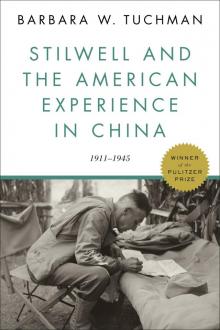 Stilwell and the American Experience in China, 1911-45
Stilwell and the American Experience in China, 1911-45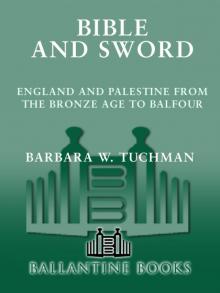 Bible and Sword: England and Palestine From the Bronze Age to Balfour
Bible and Sword: England and Palestine From the Bronze Age to Balfour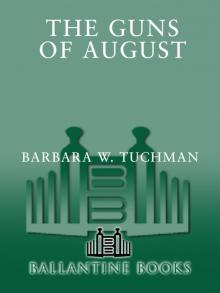 The Guns of August
The Guns of August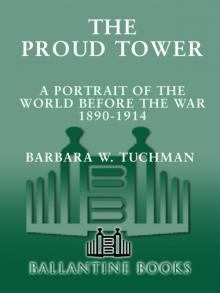 The Proud Tower: A Portrait of the World Before the War, 1890-1914
The Proud Tower: A Portrait of the World Before the War, 1890-1914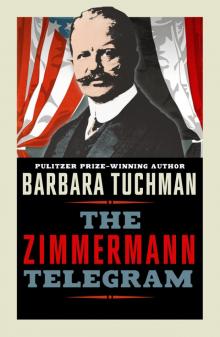 The Zimmermann Telegram
The Zimmermann Telegram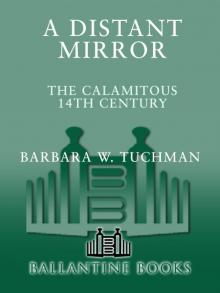 A Distant Mirror: The Calamitous 14th Century
A Distant Mirror: The Calamitous 14th Century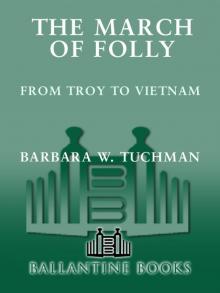 The March of Folly: From Troy to Vietnam
The March of Folly: From Troy to Vietnam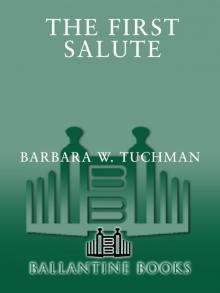 The First Salute
The First Salute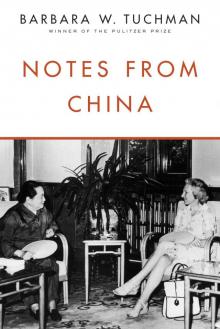 Notes From China
Notes From China Practicing History
Practicing History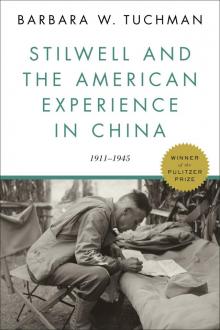 Stilwell and the American Experience in China
Stilwell and the American Experience in China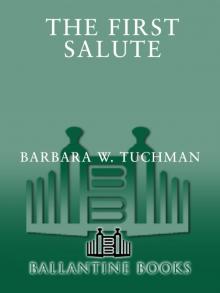 First Salute
First Salute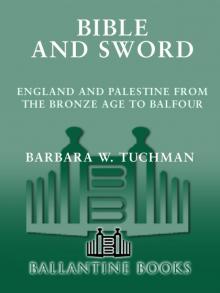 Bible and Sword
Bible and Sword